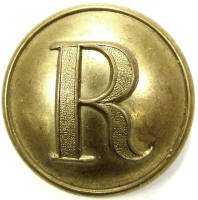
A virtual examination of artifacts of the American Civil War
 |
Ridgeway Civil War Research Center, A virtual examination of artifacts of the American Civil War |
| Civil War Artillery | |
| by Harry Ridgeway |
| Rifled artillery projectile, Schenkl design, Federal manufacture, bursting shell, "case shot", lead balls packed in asphalt matrix, rounded nose, paper sleeve sabot, Schenkl combination fuze early pattern, Ordnance rifle, 3 in. Projectile was manufactured in the Federal arsenals, following the design of John P. Schenkl. The sabot system consisted of a "forcing cone" paper sleeve, which was intended to expand into the rifling, then flutter away on release. Problems with the paper absorbing moisture or swelling and blocking passage of the flame on firing rendered it impractical with time fuzes and so it saw limited application. This pattern with rounded shoulder was designed to hold "case shot" balls, designed to disperse above the heads of troops in the open field. Lead balls of small size, about .54in. diameter, are packed in black or asphalt matrix, with long powder train which often will be off center. Fuze employed was the Schenkl combination fuze, which was a complicated contraption designed to ignite either by time or on impact. This "early" pattern fuze has the percussion mechanism on the top of the fuze, Jones pg. 104. Projectile measures: diameter 2.94in., length 9in. (excluding the fuze), weight 9lbs. Research Center: Artillery5311-Schenkl, Ref: Dickey & George, Field Artillery (1993 Edition), pg. 299. Details click: http://relicman.com/artillery/Artillery5311-Schenkl.html. |
| Ridgeway Civil War Research Center, A virtual examination of artifacts of the American Civil War. Artillery Research center, artillery, click: http://relicman.com/artillery/Artillery0000-Index.html. Research center, artillery, click: http://relicman.com/artillery/Artillery0000-Index.html. |
| Civil War Relicman, Harry Ridgeway, Civil War artillery, Relicman sales catalog. Click here: http://relicman.com/artillery/RelicmanSalesArtillery1.html. Artillery for sale: http://relicman.com/artillery/RelicmanSalesArtillery1.html. |